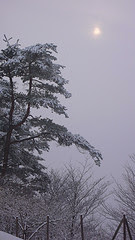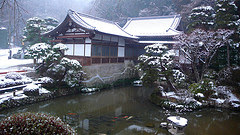 Live from Chichibu! Today the snowflakes came drifting down, spiralling, and floating and at times thickly plummeting.
Live from Chichibu! Today the snowflakes came drifting down, spiralling, and floating and at times thickly plummeting.  About 15cm of snow built up in the best spots around the caravan and I enjoyed practising from inside my warm abode while looking out at the silent, peacefully gliding scenery of brilliant reflective luminosity until my lesson at 13:00. Chichibu streets were transformed as the cloud-pruned and
About 15cm of snow built up in the best spots around the caravan and I enjoyed practising from inside my warm abode while looking out at the silent, peacefully gliding scenery of brilliant reflective luminosity until my lesson at 13:00. Chichibu streets were transformed as the cloud-pruned and  rigourously trimmed bushes gathered caps of gleaming crystals on top and that invigorating crunching sound of snow squelched out from under my boots as
rigourously trimmed bushes gathered caps of gleaming crystals on top and that invigorating crunching sound of snow squelched out from under my boots as I walked over to Sensei's. There was a little hint of excitement in the air as snowmen started to pop up here and there. Repeatedly fragments of movies darted through my mind, like Snow falling on Cedars (albeit set off Washington in USA) and the final scene of the first Kill Bill (in the snowy rock garden) in which the cedars and traditional Japanese trees are laden with snow to a continual flutter of falling snowflakes. The landscape is suddenly enchanted.
I walked over to Sensei's. There was a little hint of excitement in the air as snowmen started to pop up here and there. Repeatedly fragments of movies darted through my mind, like Snow falling on Cedars (albeit set off Washington in USA) and the final scene of the first Kill Bill (in the snowy rock garden) in which the cedars and traditional Japanese trees are laden with snow to a continual flutter of falling snowflakes. The landscape is suddenly enchanted.





I was thrilled that Megumi and Kakizakai Sensei suggested that Megumi and I could go out for a drive to the Nagatoro (長瀞町 Nagatoro-machi) area. We passed Minoyama, famous for its cherry blossoms in spring and the Natural History Museum that purportedly houses a large
 shark-like prehistoric monster reconstructed from its teeth and a rare paleoparadoxia tabadai skeleton (an extinct marine mammal from 15 million years ago), and climbed over the slippery, snowy rocks onto the platform of Iwa-datami (長瀞の岩畳), meaning Rock Tatami or carpet of rock, indeed formed from a giant continuous rock formation from crystalline schist creating successive overlapping layers of greeny-silvery rock. This geological feature is believed to have been created in the ocean (when the area was covered by the sea) and shaped later by the river. The Nagatoro River is well known for its rapids and whitewater rafting and boating, and the entire town is designated as a prefectural nature park and preserve. Megumi and I marvelled at the perfect flower formations of the snowflakes.
shark-like prehistoric monster reconstructed from its teeth and a rare paleoparadoxia tabadai skeleton (an extinct marine mammal from 15 million years ago), and climbed over the slippery, snowy rocks onto the platform of Iwa-datami (長瀞の岩畳), meaning Rock Tatami or carpet of rock, indeed formed from a giant continuous rock formation from crystalline schist creating successive overlapping layers of greeny-silvery rock. This geological feature is believed to have been created in the ocean (when the area was covered by the sea) and shaped later by the river. The Nagatoro River is well known for its rapids and whitewater rafting and boating, and the entire town is designated as a prefectural nature park and preserve. Megumi and I marvelled at the perfect flower formations of the snowflakes.











Then we went to Hodo-san and Hodo-Jinja, one of the three most famous shrines of Chichibu along with Mitsumine and Chichibu Jinja. Hodo-san ropeway transports you 774ft up the mountain rise to the Rou-bai En, park of Rou-bai plants, that bear hanging golden flowers blooming in winter, here beautiful under the glistening crystals of snow against a backdrop of white haze and still falling snow, once more luscious crunching underfoot. Rou is the candle wax and Bai is Japanese plum, reflecting the lantern-like habit of the plant and glowing colour. There are also pink (or red) ones (Kou -bai). Treading in the virgin snow along the rows and rows of Rou-bai, the gentle perfume of the blossoms filled the air with a pleasantly delicate fragrance.










 On the mountaintop amongst the cedars was Oku-No-In, a kind of secondary shrine to the main Hodo-Jinja downhill, this one stands on the summit in the woods, marked by a long ascending staircase and white torii, guarded by some cheerful-looking fox statues. The snow was powdery and quite deep in parts: pure. Finally, we descended the ropeway (suspended gondola) and went to the main Hodo-Jinja past some somewhat kinked and semi-frozen-looking carp and to the shrine that claims to be 1900 years old, we assumed the site not the wooden building itself. Various kami/god manifestations of Shinto spirits live here, included one in a waterhole and there is a shrine for studying, fox shrine and so on.
On the mountaintop amongst the cedars was Oku-No-In, a kind of secondary shrine to the main Hodo-Jinja downhill, this one stands on the summit in the woods, marked by a long ascending staircase and white torii, guarded by some cheerful-looking fox statues. The snow was powdery and quite deep in parts: pure. Finally, we descended the ropeway (suspended gondola) and went to the main Hodo-Jinja past some somewhat kinked and semi-frozen-looking carp and to the shrine that claims to be 1900 years old, we assumed the site not the wooden building itself. Various kami/god manifestations of Shinto spirits live here, included one in a waterhole and there is a shrine for studying, fox shrine and so on.




















